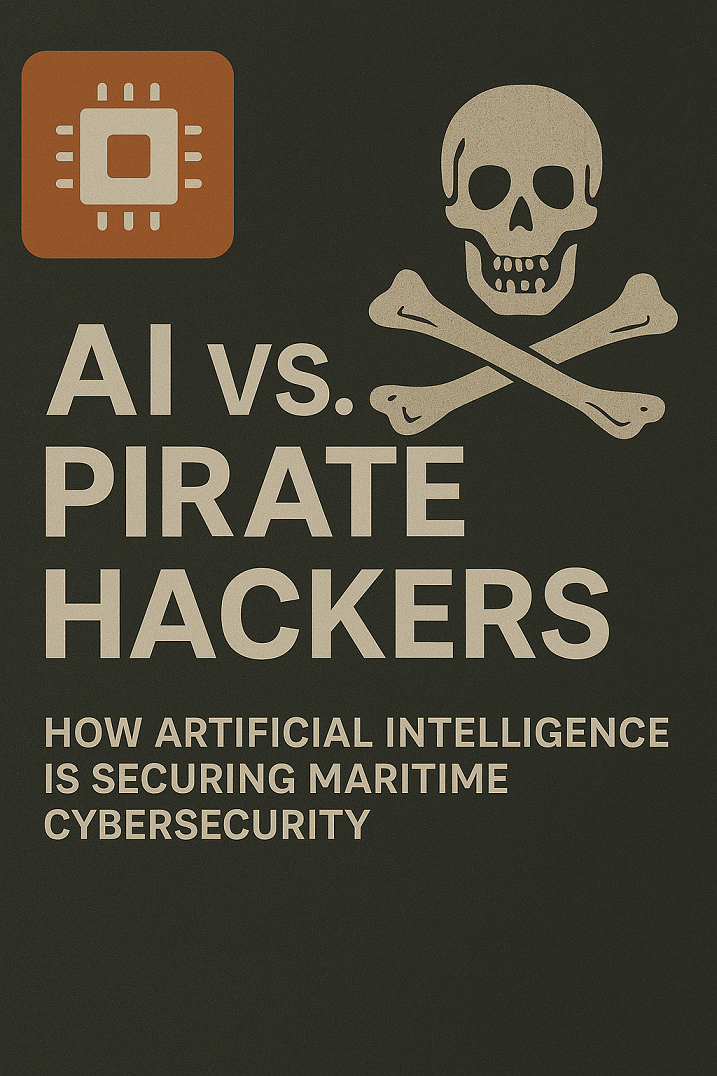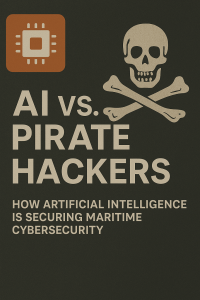Explore how AI is transforming maritime cybersecurity by fighting pirate hackers, preventing GPS spoofing, and defending shipping companies from cyberattacks. A must-read for cadets, ship officers, and maritime professionals.
What if your cargo ship’s GPS suddenly showed you sailing into a different ocean—or off course into hostile waters?
As maritime systems become more digitized, the risks of cyberattacks at sea have skyrocketed. From GPS spoofing and ransomware attacks to data breaches and electronic chart manipulation, the threat of “pirate hackers” is real. Fortunately, AI in maritime cybersecurity is emerging as a powerful shield, enabling smarter detection, faster response, and adaptive protection.
In this article, we’ll explore:
-
How AI combats cyberattacks in the maritime sector
-
Whether AI can prevent GPS spoofing on cargo ships
-
Real-world applications and future trends in maritime digital security
All tailored for students, cadets, ship officers, shipping companies, and maritime cybersecurity enthusiasts.
What Is Maritime Cybersecurity?
Maritime cybersecurity refers to protecting digital and networked systems aboard ships and at ports from cyber threats. These include:
-
Navigation and communication systems (e.g., ECDIS, AIS, GPS)
-
Propulsion and cargo handling control systems (OT/ICS)
-
Shore-side networks connected to the ship via satellites or 5G
-
Crew and administrative IT systems (email, cloud storage, etc.)
As ships become smarter and more connected, they also become more vulnerable to digital attacks.
💥 In 2017, Maersk, one of the world’s largest shipping companies, suffered a NotPetya ransomware attack—costing over $300 million in damages.
🔐 AI vs. Pirate Hackers: A New Line of Defense
AI vs. pirate hackers is not just a catchy phrase—it’s a strategic reality. Artificial intelligence is now being used to:
-
Detect unusual patterns in ship network traffic
-
Block phishing attempts in real time
-
Identify suspicious logins or unauthorized control system access
-
Automatically isolate compromised systems
How AI Secures Ships:
-
Behavioral Analytics: AI learns what “normal” activity looks like and flags anomalies (e.g., logins from unexpected IPs or ports).
-
Machine Learning Models: Predict and respond to zero-day threats based on past attack data.
-
AI-driven Firewalls and IDS (Intrusion Detection Systems): Dynamically adjust rules to block new threats without manual input.
-
Automated Threat Response: Can quarantine devices or shut down a digital route if an attack is suspected.
📊 Stat: According to Allianz’s Safety & Shipping Review, over 70% of shipping companies surveyed in 2023 were integrating AI-based cybersecurity measures into their operations.
🛰️ Can AI Prevent GPS Spoofing in Cargo Ships?
What is GPS Spoofing?
GPS spoofing involves falsifying a ship’s location by feeding it counterfeit satellite signals. It can lead to:
-
Navigation errors
-
Unauthorized entry into restricted waters
-
Potential collisions and legal liabilities
How AI Fights Back:
-
Cross-Validation Systems: AI compares GPS data with AIS, radar, and inertial navigation to detect discrepancies.
-
Anomaly Detection Algorithms: Machine learning identifies suspicious behavior (e.g., erratic course changes, speed mismatches).
-
Signal Authentication: AI filters real satellite signals from fake ones by analyzing signal strength, time shifts, and source triangulation.
Real-World Application:
Ports in South Korea and the Middle East are using AI-enhanced anti-spoofing systems to monitor incoming ships. When a spoof is detected, port control can override the signal, alert the shipmaster, and guide the vessel safely.
⚠️ Maritime Tip: Combining AI with electronic horizon systems and non-GNSS-based backups enhances resilience against GPS manipulation.
🧠 Case Study: AI in Action – Cybersecurity on Autonomous Ships
Autonomous vessels, such as the Yara Birkeland (Norway), rely entirely on digital infrastructure to navigate and operate. AI is integrated into their safety systems to:
-
Detect malware in navigation software
-
Respond to denial-of-service (DoS) attacks on satellite communication
-
Self-recover from data corruption using blockchain-based backups
🔍 Insight: The IMO’s Guidelines on Maritime Cyber Risk Management (MSC-FAL.1/Circ.3) emphasize the need for intelligent, adaptive systems on smart ships.
🔍 Latest Trends in Maritime Cyber AI
| Trend | Description |
|---|---|
| AI-Supported Cyber Audits | AI scans OT and IT networks for vulnerabilities in real-time |
| Natural Language Processing (NLP) | Analyzes crew email traffic to detect phishing and social engineering attempts |
| Federated Learning Models | AI trains on data from multiple ships without needing to centralize it |
| Cyber Twin Technology | Digital replica of ship’s systems used to test responses to simulated attacks |
📈 Forecast: By 2026, 90% of maritime cybersecurity solutions will involve some form of AI or machine learning, according to Gartner.
FAQs: People Also Ask
What is AI’s role in maritime cybersecurity?
AI detects, analyzes, and responds to cyber threats in real time, often faster and more accurately than traditional methods.
Can AI prevent ship hacking?
AI significantly reduces the risk by flagging suspicious behavior, blocking unauthorized access, and automating countermeasures.
How common are GPS spoofing attacks in shipping?
Incidents are increasing, especially in the Black Sea, Persian Gulf, and South China Sea, where vessels have reported false positions due to spoofing.
Do STCW regulations include cybersecurity?
Yes. As of 2021, cyber risk management is included under the ISM Code, and STCW-aligned training now incorporates basic cybersecurity awareness.
Conclusion: Securing the Digital Horizon
The war between AI and pirate hackers is not fought with cannons or cutlasses, but with code, algorithms, and intelligent defenses. As cyber threats grow more sophisticated, so too must our defenses. AI is helping the maritime sector move from reactive firefighting to proactive cyber readiness.
🚢 Call to Action: For shipping companies, officers, and cadets—now is the time to invest in AI-powered cybersecurity tools. Protect your vessel, data, and crew from the growing tide of digital piracy.
References & Further Reading
Suggested Internal Links (for MaritimeEducation.com or similar)
Tackling a growing cybersecurity threat in an increasingly connected industry


